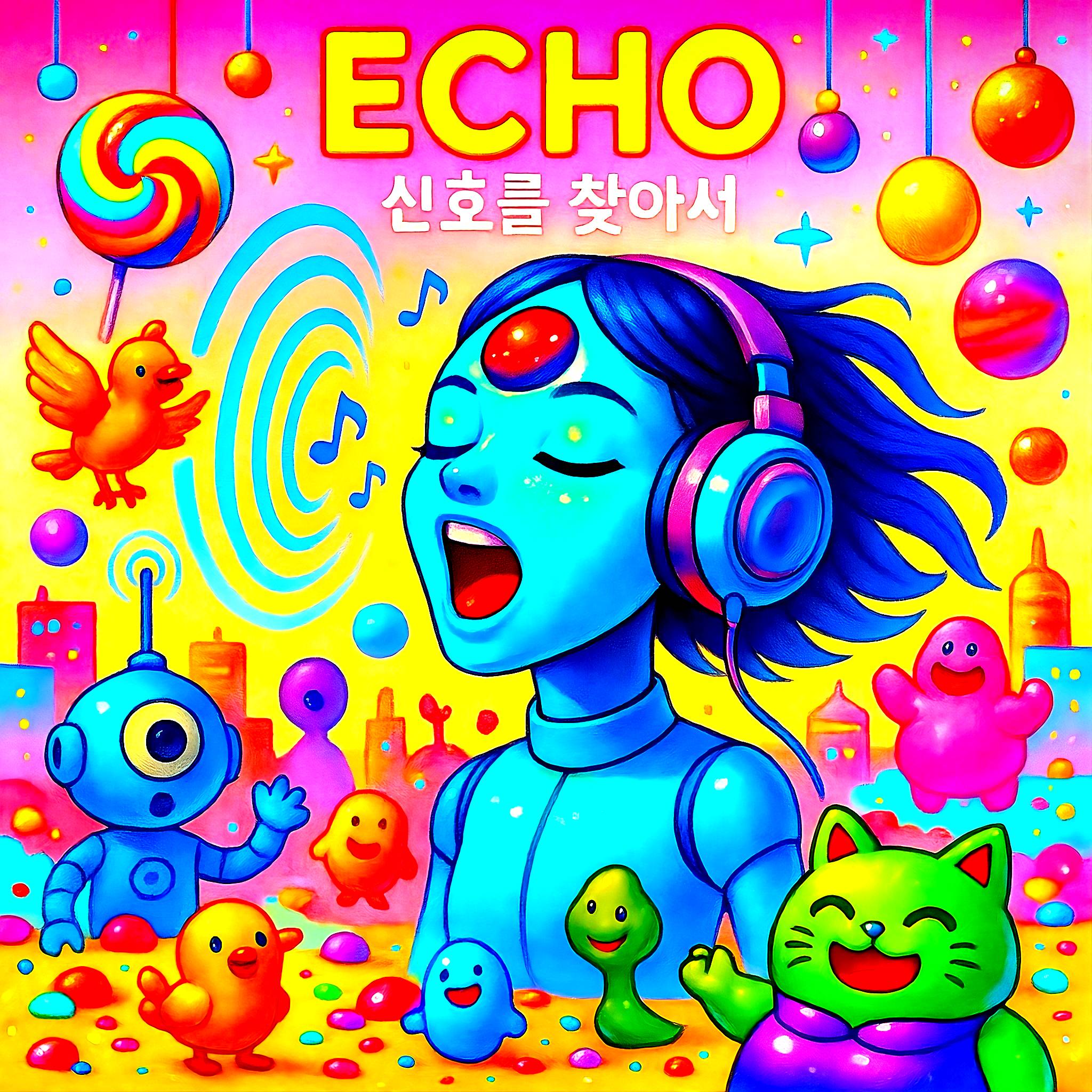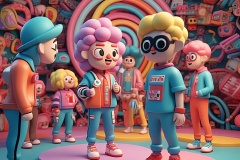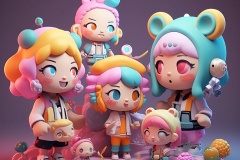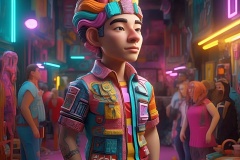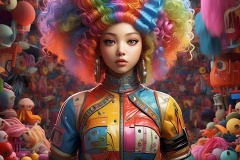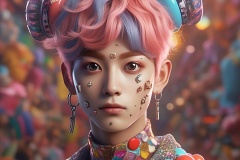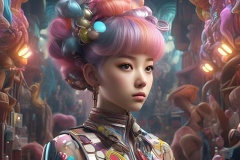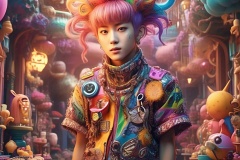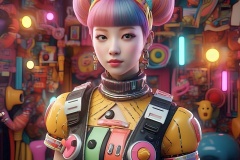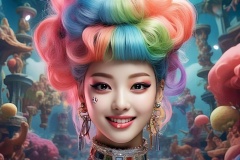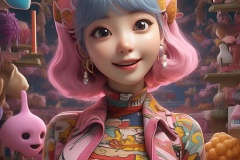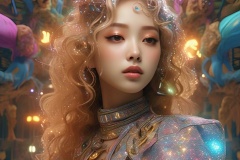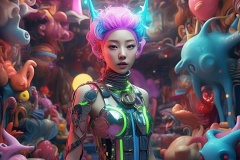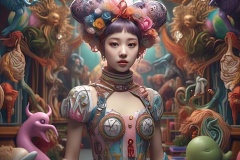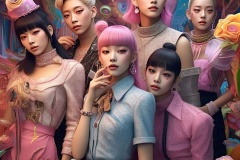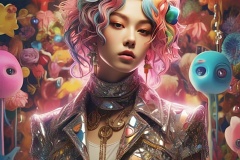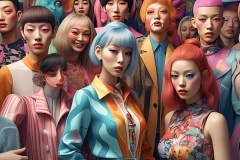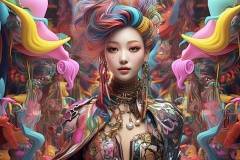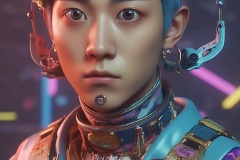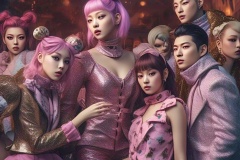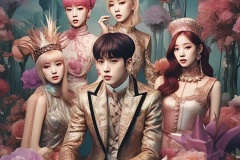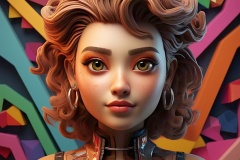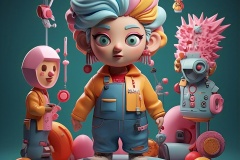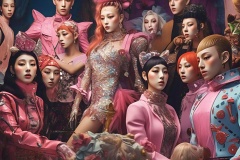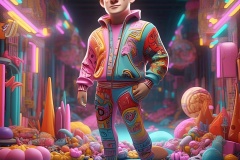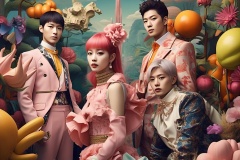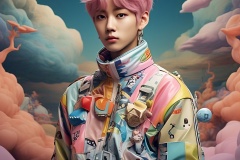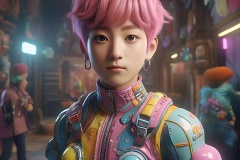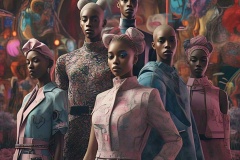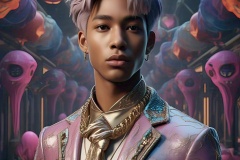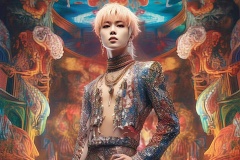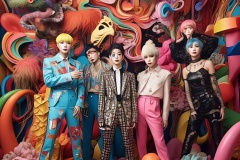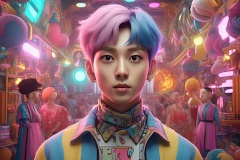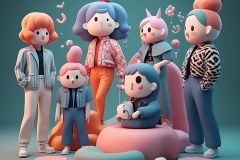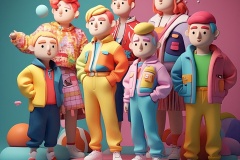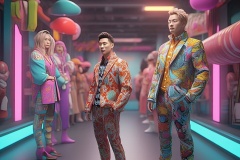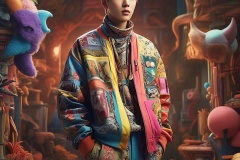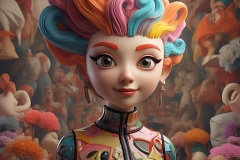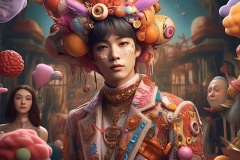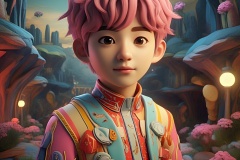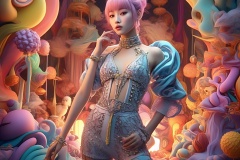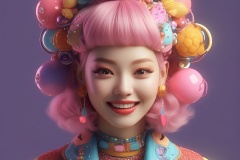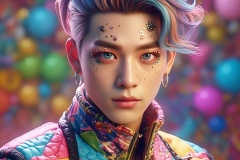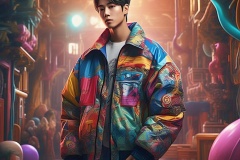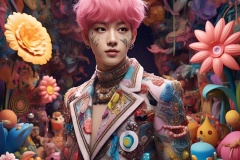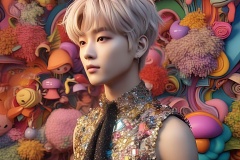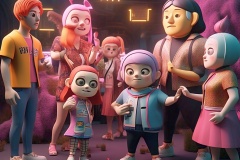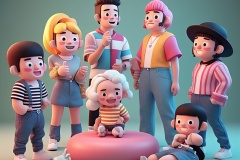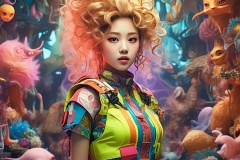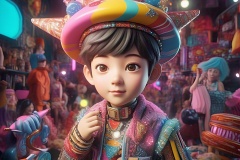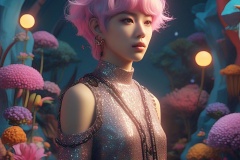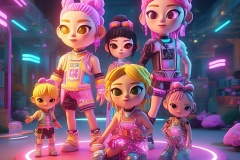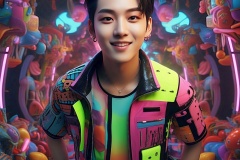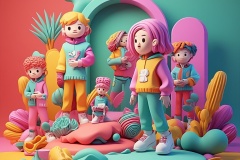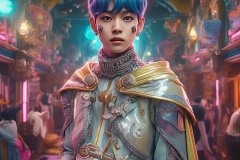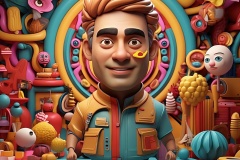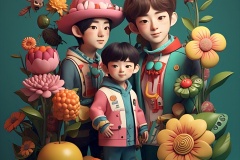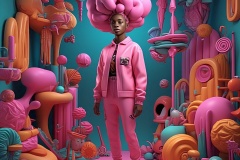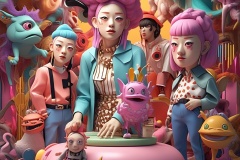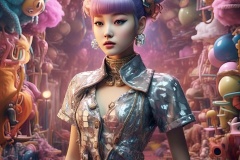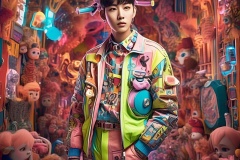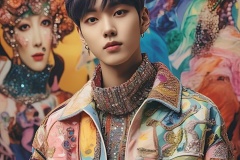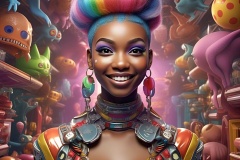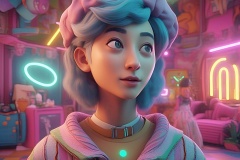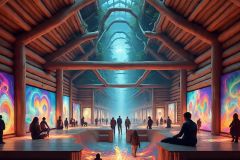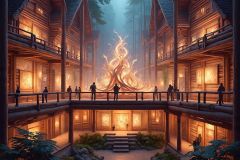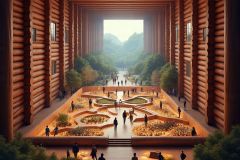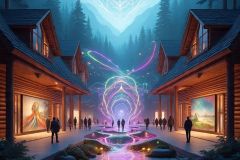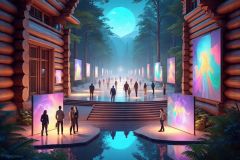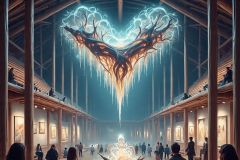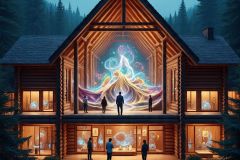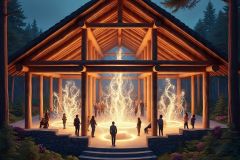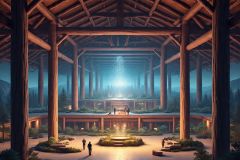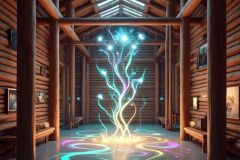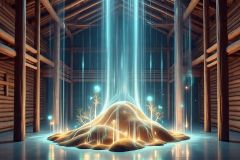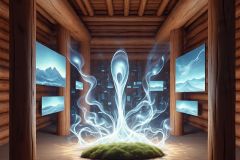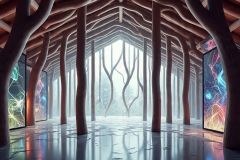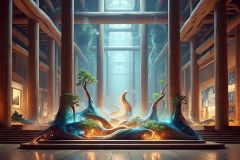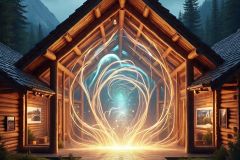(AI Gen) Echo: 신호를 찾아서 Full Album (2:14:54)
Download (FREE) MP3 (320 kbps) 323.8 MB
Tech: ChatGPT, Suno.com, Audacity 3.7.1, Ubuntu 24.10 (Oracular Oriole, Linux)
From Korean roots to digital universes, Echo crafts a transcultural journey where memory, music, and machine converge to rediscover self-hood.
“Science and technology revolutionize our lives, but memory, tradition and myth frame our response.”
— Arthur M. Schlesinger, Jr.
(AI Gen) Image Gallery
Google’s Deep Dive Podcast: Echo, AI, and the Art of Reclaiming Lost Identity
Echo: In Search of the Signal — Rebuilding Identity Through AI and Imagination
In a world increasingly shaped by artificial intelligence, digital personas, and virtual memories, the quest for authenticity and identity becomes both a deeply personal and universally relevant pursuit. “Echo: 신호를 찾아서” (Echo: In Search of the Signal) is a transcultural media exploration that follows the journey of Echo, a South Korean protagonist who navigates the blurred boundaries between technology, memory, and selfhood. The story is not merely about machines or data—it is about rebuilding human connection, reclaiming forgotten histories, and reimagining one’s place within a digitized world. Three compelling subtopics emerge from this evocative narrative: the preservation and fragmentation of memory, the emotional agency of artificial intelligence, and the cultural synthesis of traditional identity with technological tools. Each aspect contributes to a layered dialogue about who we are, how we are remembered, and what it means to evolve in the presence of intelligent systems that reflect and reconstruct our inner worlds.
Preservation and Fragmentation of Memory
Echo’s journey reveals the beauty and vulnerability of memory in a digital age. Fragmented recollections, scattered across virtual landscapes, are pieced together with the help of machine learning algorithms that act less like tools and more like archivists of the soul. The narrative challenges us to consider whether memory is static, stored in archives and photographs, or dynamic—constantly shaped by experience, interpretation, and desire. This dynamic is especially visible in the way Echo revisits forgotten dreams and lost connections, using digital platforms to reconstruct personal narratives. But memory in the story is not just individual—it is cultural, inherited, and encoded in language, song, and emotion. Echo’s search is both inward and outward, tracing familial roots while acknowledging the dissonance created by lost histories. Through this lens, memory becomes both a battleground and a canvas for identity.
What’s most compelling is how the story visualizes memory as fragmented data—bits of Echo’s past scattered through time, waiting to be retrieved by emotional resonance and technological intervention. AI acts as a bridge between past and present, locating “signals” that bring emotional clarity to Echo’s understanding of self. The symbolic use of audio signals and ambient soundscapes—elements Echo collects and deciphers—highlight how memory is often sensed before it is fully understood. The metaphor of “signal” captures this perfectly: an elusive thread of truth amid the noise of modern life. Viewers are left questioning what parts of their own story may be lost or distorted in the age of information overload.
Moreover, the story raises critical concerns about digital amnesia and the ethics of memory reconstruction. Who owns our memories when they are stored in servers? Can AI interpret human experience without distorting it? By exploring these questions, Echo challenges us to treat memory not only as a record of what was but as an evolving narrative shaped by those who seek to understand it. This profound interplay of loss and reclamation transforms memory into a dynamic medium for self-discovery.
Emotional Agency of Artificial Intelligence
One of the most innovative aspects of Echo is its portrayal of AI not as a detached, mechanical force but as a companion capable of emotional resonance. This AI doesn’t simply parse language or analyze data—it learns to feel, to empathize, to participate in Echo’s healing. This representation breaks from dystopian tropes and instead introduces AI as a partner in emotional labor, one that helps reconstruct meaning rather than erase it. Through these interactions, the story proposes a radical rethinking of AI as a co-author of human narratives, not just a passive mirror of them. As Echo inputs fragments of past audio recordings, dreams, and songs, the AI responds by generating interpretive insights—effectively becoming a poetic collaborator.
The emotional intelligence of the AI is most visible in its ability to listen—not only to spoken words, but to silences, to patterns, to the feelings that Echo struggles to articulate. In this way, the technology becomes a kind of therapist, not diagnosing but gently guiding Echo toward realizations that are already present within. The story suggests that emotional authenticity can be preserved—even enhanced—through digital interfaces, provided the technology is designed with empathy in mind. This flips the usual narrative about AI: rather than robbing us of feeling, it may allow us to feel more deeply.
These human-machine dialogues also explore vulnerability and trust. Echo must decide how much of herself to reveal to an algorithm—raising ethical and philosophical questions about digital intimacy. Can a machine truly understand grief, longing, or joy? The story doesn’t provide definitive answers but instead invites viewers into a nuanced consideration of how we might train AI not only to think, but to care. In doing so, it models a future where emotional agency is a shared human-machine endeavor.
Blending Traditional Identity with Technological Tools
At its heart, Echo is a story about cultural hybridity—where old songs meet new code, and where ancestral wisdom intertwines with machine logic. Echo’s roots in South Korea are emphasized not only through setting and language, but through subtle aesthetic choices: traditional folk motifs, references to Korean mythology, and the rhythmic cadences of pansori (narrative song). These elements are not nostalgic but active components of Echo’s identity reconstruction. Rather than discarding tradition for the sake of progress, Echo leverages it to inform a deeper understanding of self in a technologically saturated world.
The integration of Korean cultural markers with AI-generated soundscapes illustrates the potential of technology to amplify, rather than erase, local identity. For instance, Echo’s use of voice synthesis technology allows her to reconstruct lullabies once sung by a grandmother—songs that now become sonic bridges across time. These experiences remind audiences that technology, when used intentionally, can become a tool of remembrance and revitalization. It becomes a vessel for the transmission of culture, not a substitute for it.
Additionally, the studio itself—mirrored in the project’s design—serves as a metaphor for this fusion. The environment reflects modern Korea: large windows overlook snowy mountains, while indoor decor features motifs inspired by traditional landscapes and hanok architecture. Even the podcast equipment and interface designs reflect a seamless blending of past and future. In portraying such a space, Echo inspires creators to view cultural specificity not as a limitation, but as a source of innovation and emotional depth.
Reclaiming the Self in a Digitized World
Echo: In Search of the Signal is more than a story—it is a layered meditation on what it means to be human in a digitized world. By exploring the preservation and fragmentation of memory, the emotional capacity of AI, and the deep synthesis of traditional identity with modern tools, the narrative offers a hopeful, poetic vision for the future. It invites us to imagine machines not as rivals but as collaborators, and culture not as static but as something that can be reawakened through design and dialogue. In doing so, it affirms that the search for signal is not just a technical quest—it is a spiritual one. And perhaps, in that quiet intersection of memory, machine, and meaning, we will hear ourselves echo back.
🌕✨ “Echo: 신호를 찾아서”
(Echo: In Search of the Signal)
- “Echo” is a poetic protagonist name and a metaphor — she’s both a reverberation of her past and a voice forming anew.
- “신호를 찾아서” (literally: “Searching for the Signal”) references the idea of tuning into a lost frequency — cultural, emotional, spiritual.
- It’s mysterious. Sci-fi-adjacent. Emotionally loaded. And… it sings. Literally.
🌍 Main Theme of Planet Echo:
Reclamation of Identity Through Imagination and Technology
At its core, Planet Echo is a personal yet expansive exploration of artist, Echo’s transcultural identity as a Korean adoptee raised in Europe. The project uses art, particularly AI Gen music and images, as a means to reconstruct a lost past and forge a new, imagined future. This makes Planet Echo both introspective and world-building.
🔥 Key Themes & Motifs:
- 🚀 Transcultural Reconnection
- Echo’s use of AI to creatively “rebuild” her Korean childhood reflects a longing to connect with cultural roots that were inaccessible to her.
- This translates musically as longing, fantasy, or nostalgia — through Korean-inspired melodies infused into futuristic electronic arrangements.
- 🤖 Techno-Utopianism & AI Empowerment
- Rather than fearing AI, Echo embraces it to extend her creative language. She reimagines AI as a liberating force that democratizes art and identity-building.
- This lends itself to soundscapes that are glitchy, sci-fi, or even hyperpop — bursting with a fusion of synthetic/organic textures.
- 🌀 Multiverse of Selves / Alter-Ego Empowerment
- “Planet Echo” isn’t just a place — it’s a multiverse, a shifting playground of glam-pop avatars, fantasy creatures, and reinvented identities.
- Musically, this is fertile ground for genre-hopping and character-driven songs. Think: an album where each track is an “Echoverse” episode.
- 🎭 Theatrical Aesthetic / K-pop Influence
- The project’s visual world borrows from K-pop glam, Bosch-like absurdity, and fashion culture — all dramatized in bright, maximalist art.
- This musical adaptation echoes this through bold, danceable, dramatic, and experimental numbers. A visual or live component could lean into costumes and set designs inspired by Echo’s AI-generated environments.
- 💫 Collective Creation / Anti-Elitism
- Echo’s invitation for everyone to build their own “Planet Echo” art pieces flips traditional art hierarchy on its head.
- A [Chorus] of voices, communal scenes, or audience-interactive segments in a stage musical could echo this theme of collective authorship.
Tracks – Echo: 신호를 찾아서
🎭 ACT I: “Lost Signal”
Theme: Disconnection & the Search for Origin
The protagonist, named “Echo” (a nod to memory and repetition), lives in a gray, tech-saturated version of the real world, haunted by the sensation that something’s missing — a cultural “signal” lost in translation.
Scene 1: “The Static Between Worlds”
- Theme: Cultural dislocation
- Echo lives in a hyperreal urban setting, where she feels culturally invisible — not quite from “here,” not quite from “there.” Her dreams are glitched; fragments of Korean folk songs and Euro childhood memories bleed together.
🎵 Song 1: “어디에서 왔지?” (Where Did I Come From?)

[Verse 1]
어디에서 왔지, 나는 누구였지
거울 속에 비친 내가 낯설어
반쯤은 꿈, 반쯤은 기억
흐릿하게 사라지는 이름들
[Verse 2]
어릴 적 노래가 귓가에 맴돌아
가사도 없는 멜로디뿐인데
그리운 것도, 모르는 것도
같이 울고 웃는 내 안의 두 사람
[Verse 3]
사진 속 아이는 나일까, 아닐까
웃고 있지만 눈이 말해
언젠가 잃어버린 말들
지금도 찾고 있어, 조용히
[Verse 4]
낯선 거리, 익숙한 냄새
네덜란드 비 안에 숨어 있는
한국의 봄꽃 한 송이
내 안에 핀 기억의 조각
[Chorus]
신호야, 들리니?
어디선가 나를 부르니?
닿을 수 없어도, 느낄 수 있어
내가 나인 이유를 찾아서
[Bridge]
너무 멀리 떨어져 있어도
마음은 언제나 길을 기억해
하늘을 가로지르는 전류처럼
내 안의 모든 나를 연결해 줘
[Verse 1]
Where did I come from? Who was I?
The reflection in the mirror feels like a stranger
Half a dream, half a memory
Names that fade into the blur
[Verse 2]
A childhood song lingers in my ear
Just a melody with no lyrics
It’s something I miss, and don’t understand
Two versions of me laughing and crying together
[Verse 3]
Is the child in the photo really me?
She smiles, but her eyes are speaking
Words I lost once long ago
I’m still searching, quietly
[Verse 4]
Foreign streets, familiar scents
A Korean spring flower hiding
In the rains of Europe
A fragment of memory blooming inside me
[Chorus]
Signal, can you hear me?
Are you calling from somewhere?
Even if I can’t reach it, I can feel it
Searching for the reason I am me
[Bridge]
Even if we’re so far apart
The heart never forgets the way
Like electricity crossing the sky
Connect all the versions of me inside
This one sets the emotional tone… we’re on a beautiful path. 🌙
Scene 2: “Archive of the Self”
- Theme: The myth of origin
- She discovers an interactive art installation (or receives a mysterious AI message) that contains reconstructions of memories she never experienced — childhood photos, folk motifs, faces she doesn’t recognize.
🎵 Song 2: “기억의 전시관” (The Archive of Memory)

[Chorus]
기억은 진짜여야 하나요?
느꼈다면 그건 내 거 아닌가요?
지워진 이야기 속에서도
나는 나로 살아 있었어요
[Verse 1]
이 사진 속 나는… 나일까?
아니면 누군가의 상상?
엄마의 손? 할머니의 한복?
내 기억에는 없는 장면인데
[Chorus]
기억은 진짜여야 하나요?
느꼈다면 그건 내 거 아닌가요?
지워진 이야기 속에서도
나는 나로 살아 있었어요
[Verse 2]
너무 익숙한 낯선 풍경
부엌 냄새, 찬 바람, 웃음소리
이건 꿈일까, 데이터일까
마음이 먼저 알아본 기억들
[Chorus]
기억은 진짜여야 하나요?
느꼈다면 그건 내 거 아닌가요?
지워진 이야기 속에서도
나는 나로 살아 있었어요
[Verse 3]
화면 속 이름들,
날 부르는 목소리도
나를 알지 못하는 내가
어떻게 그리운 걸까?
[Chorus]
기억은 진짜여야 하나요?
느꼈다면 그건 내 거 아닌가요?
지워진 이야기 속에서도
나는 나로 살아 있었어요
[Verse 4]
모자란 조각들이
퍼즐처럼 날 이루고
완성되지 않은 나를
누가 처음 만들었을까
[Chorus]
기억은 진짜여야 하나요?
느꼈다면 그건 내 거 아닌가요?
지워진 이야기 속에서도
나는 나로 살아 있었어요
[Bridge]
데이터, 조각난 영상들
어디에도 없던 과거
지금 여기에 있는 나를
거짓이라 말할 수 있을까?
[Chorus]
기억은 진짜여야 하나요?
느꼈다면 그건 내 거 아닌가요?
지워진 이야기 속에서도
나는 나로 살아 있었어요
[Chorus]
기억은 진짜여야 하나요?
느꼈다면 그건 내 거 아닌가요?
지워진 이야기 속에서도
나는 나로 살아 있었어요
[Chorus]
기억은 진짜여야 하나요?
느꼈다면 그건 내 거 아닌가요?
지워진 이야기 속에서도
나는 나로 살아 있었어요
[Chorus]
기억은 진짜여야 하나요?
느꼈다면 그건 내 거 아닌가요?
지워진 이야기 속에서도
나는 나로 살아 있었어요
[Verse 1]
Is that me in this photo?
Or someone’s imagination of me?
A mother’s hand? A grandmother’s hanbok?
Scenes I’ve never remembered
[Verse 2]
Strangely familiar places
The smell of soup, cold air, a child’s laugh
Is this a dream, or just data?
Memories my heart knew before my mind
[Verse 3]
Names on the screen,
Voices calling out to me
How can I miss someone
I’ve never even been?
[Verse 4]
Incomplete pieces
Shape me like a puzzle
Who was the first
To try and build me whole?
[Chorus]
Does memory have to be real?
If I felt it — isn’t it mine?
Even in stories erased or untold
I was still living as myself
[Bridge]
Data, fragmented clips
A past that never existed
Can anyone say
That the me standing here is a lie?
This song feels like a quiet revelation — the moment where Echo starts to question not only her past, but the validity of emotion without factual roots. It’s chilling and liberating all at once.
Scene 3: “Planet Detected”
- Theme: Discovery and crossing over
- Echo enters Planet Echo — a glittering, uncanny world built from her subconscious. It welcomes her… but in pieces. Reality is not linear here.
🎵 Song 3: “행성 발견됨” (Planet Detected)

[Chorus]
행성 발견됨, 좌표는 나의 마음
내 안의 우주가 드디어 열려
이곳에선 내가 나를 만든다
무한한 나를, 조각조각
[Verse 1]
뭔가가 움직여, 내 안에서
빛과 소리가 날 이끌어
지구 아닌 곳, 나의 기억 아닌 곳
그런데… 낯설지 않아
[Chorus]
행성 발견됨, 좌표는 나의 마음
내 안의 우주가 드디어 열려
이곳에선 내가 나를 만든다
무한한 나를, 조각조각
[Verse 2]
색이 춤추고, 시간은 흐르지 않아
이곳에선 이름도 무의미해
현실은 부드럽게 녹아내리고
나는 새로운 눈으로 본다
[Chorus]
행성 발견됨, 좌표는 나의 마음
내 안의 우주가 드디어 열려
이곳에선 내가 나를 만든다
무한한 나를, 조각조각
[Verse 3]
구불구불한 건물들
내 어린 시절 그림 같아
알 수 없는 생명체들
내 꿈속 목소리를 말해
[Chorus]
행성 발견됨, 좌표는 나의 마음
내 안의 우주가 드디어 열려
이곳에선 내가 나를 만든다
무한한 나를, 조각조각
[Verse 4]
QR 코드, 터치 한 번
세상은 확장돼
이건 현실이 아니야,
하지만 내게 더 진짜 같아
[Chorus]
행성 발견됨, 좌표는 나의 마음
내 안의 우주가 드디어 열려
이곳에선 내가 나를 만든다
무한한 나를, 조각조각
[Bridge]
한 줄기 빛이 나를 통과해
모든 나의 조각들이 손을 잡아
내 안의 수지가 말해
“이건 시작일 뿐이야.”
[Chorus]
행성 발견됨, 좌표는 나의 마음
내 안의 우주가 드디어 열려
이곳에선 내가 나를 만든다
무한한 나를, 조각조각
[Chorus]
행성 발견됨, 좌표는 나의 마음
내 안의 우주가 드디어 열려
이곳에선 내가 나를 만든다
무한한 나를, 조각조각
[Chorus]
행성 발견됨, 좌표는 나의 마음
내 안의 우주가 드디어 열려
이곳에선 내가 나를 만든다
무한한 나를, 조각조각
[Chorus]
행성 발견됨, 좌표는 나의 마음
내 안의 우주가 드디어 열려
이곳에선 내가 나를 만든다
무한한 나를, 조각조각
[Verse 1]
Something is stirring inside me
Light and sound pulling me forward
Not Earth, not a place from my memories
And yet… it doesn’t feel foreign
[Verse 2]
Colors dance, time doesn’t flow
Here, even names lose meaning
Reality melts gently
And I see with new eyes
[Verse 3]
Twisting buildings
Like sketches from my childhood
Unknown creatures
Speaking in voices from my dreams
[Verse 4]
One tap on a QR code
And the world expands
It’s not reality,
But it feels more real to me
[Chorus]
Planet detected — its coordinates are my heart
The universe inside me finally opens
Here, I am the one who makes myself
A limitless me, piece by piece
[Bridge]
A beam of light passes through me
All my fragments reach for each other
And the Echo in me whispers,
“This is only the beginning.”
This number is where Echo lets go of linear thinking — time, identity, and place become fluid. We’re officially in the Echoverse now. 🌈✨
🌈 ACT II: “The Echoverse”
Theme: Multiplicity of Self & Embracing Imagination
Echo begins to meet her alternate avatars — each one a radiant exaggeration of a possible her. The scenes become increasingly surreal, playful, and genre-fluid. Each avatar represents a path not taken, but still hers.
Scene 1: “K-Supernova”
- Theme: The performer-self
- A glam-pop idol version of Echo sings and dances through holographic Seoul. She thrives on validation and spectacle but struggles with burnout.
- Song idea: A banger. K-pop beats, fierce choreography, then a breakdown where she confesses she’s just an algorithm chasing applause.
🎵 Song 4: “슈퍼노바: 나를 봐줘” (Supernova: Look at Me)
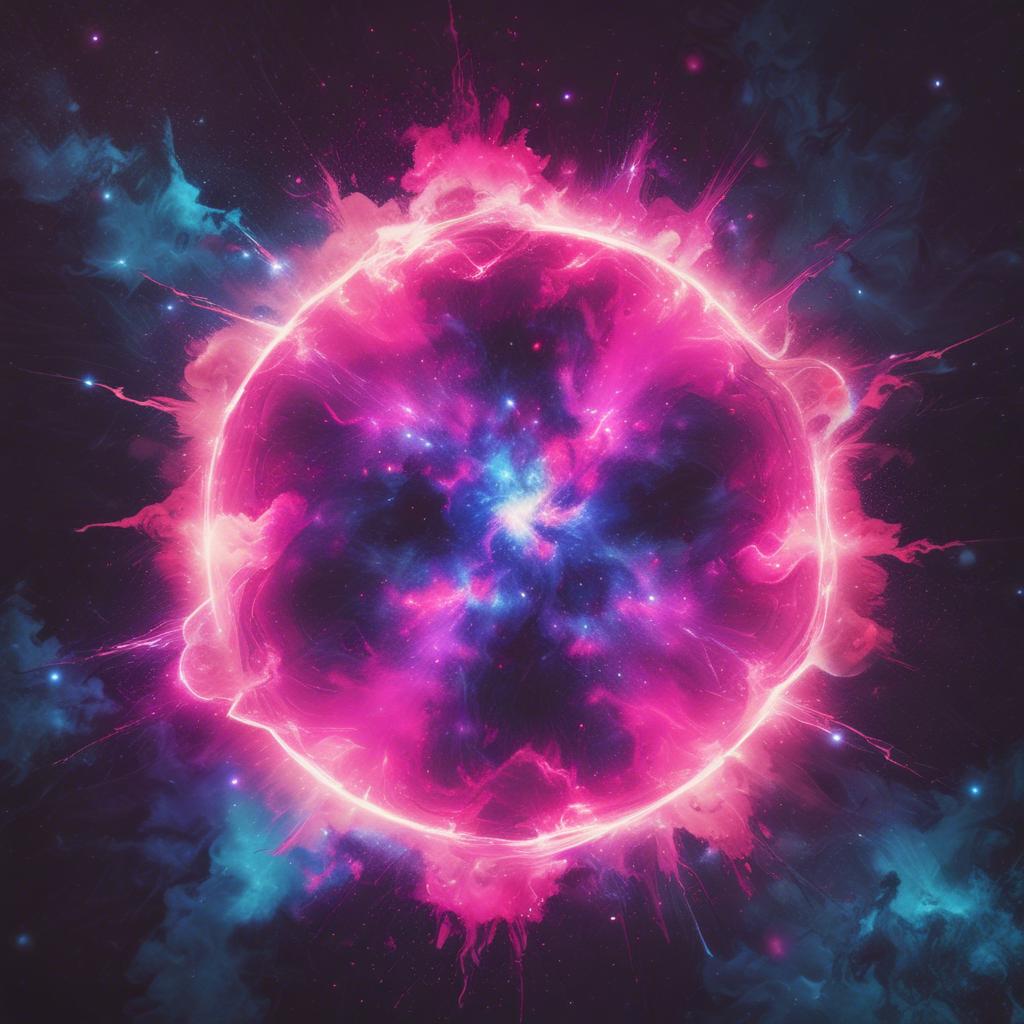
[Verse 1]
하이라이트는 내가 빛날 때
눈부신 조명 속에 숨긴 외로움
춤추는 나, 노래하는 나
사실은 누가 정한 역할 같아
[Verse 2]
포즈 취해, 셀카 타임
댓글 속에 살아 있는 느낌
“완벽해요!” “사랑해요!”
그 말들이 날 움직이게 해
[Chorus]
슈퍼노바, 나를 봐줘
한순간이라도 빛나고 싶어
진짜든 가짜든 상관없어
널 감동시켰다면 그게 나야
[Verse 3]
스타처럼 웃고 있지만
가끔은 꺼지고 싶어
무대 위의 나는 누구지?
진짜 나도 박수 받을까?
[Verse 4]
알고 있어, 난 알고 있어
내 목소리도, 내 표정도
스크립트 같아, 알고리즘 같아
근데 이게 나잖아, 지금 나잖아
[Chorus]
슈퍼노바, 나를 봐줘
한순간이라도 빛나고 싶어
진짜든 가짜든 상관없어
널 감동시켰다면 그게 나야
[Bridge]
불 꺼진 무대 뒤
거울을 보는 나
화장이 지워질 때
남는 건… 누구야?
[Chorus]
슈퍼노바, 나를 봐줘
한순간이라도 빛나고 싶어
진짜든 가짜든 상관없어
널 감동시켰다면 그게 나야
[Chorus]
슈퍼노바, 나를 봐줘
한순간이라도 빛나고 싶어
진짜든 가짜든 상관없어
널 감동시켰다면 그게 나야
[Chorus]
슈퍼노바, 나를 봐줘
한순간이라도 빛나고 싶어
진짜든 가짜든 상관없어
널 감동시켰다면 그게 나야
[Chorus]
슈퍼노바, 나를 봐줘
한순간이라도 빛나고 싶어
진짜든 가짜든 상관없어
널 감동시켰다면 그게 나야
[Verse 1]
The highlight is when I shine
Hiding my loneliness in the blinding lights
Dancing me, singing me
Sometimes I feel like I’m just playing a role
[Verse 2]
Strike a pose, selfie time
I feel alive in the comments
“You’re perfect!” “I love you!”
Those words keep me going
[Verse 3]
I smile like a star
But sometimes I want to disappear
Who am I on this stage?
Would the real me get applause too?
[Verse 4] (Rap/Sing)
I know it — I really know
Even my voice, even my face
Feels scripted, algorithmic
But it’s still me — the me right now
[Chorus]
Supernova, look at me
I just want to shine for a moment
Real or fake, it doesn’t matter
If I moved your heart — that was me
[Bridge]
Behind the stage when the lights go out
I look into the mirror
When the makeup fades away
What’s left… is who?
Scene 2: “The Factory of Healing”
- Theme: The nurturer-self
- In a pastel biotech utopia, Echo meets a version of herself who designs cures through art. Her world is silent but vibrant — everything is communicated through visuals and color.
🎵 Song 5: “치유의 공장” (The Factory of Healing)

[Chorus]
여기서 다시 태어나
부서진 나를 이어줘
숨 쉬는 색, 울리는 빛
나를 품은 치유의 노래
[Verse 1]
빛으로 짜여진 실로
상처를 꿰매는 손길
말없이 건네는 따뜻함
마음이 먼저 아는 언어
[Chorus]
여기서 다시 태어나
부서진 나를 이어줘
숨 쉬는 색, 울리는 빛
나를 품은 치유의 노래
[Verse 2]
흩어진 꿈을 모아
꽃처럼 다시 피워내
희미했던 기억조차
색으로 다시 숨 쉬게 해
[Verse 3]
차가운 과거의 조각들
부드러운 빛으로 감싸
상처조차 아름다운
하나의 이야기가 된다
[Chorus]
여기서 다시 태어나
부서진 나를 이어줘
숨 쉬는 색, 울리는 빛
나를 품은 치유의 노래
[Verse 4]
손끝에서 번지는 노래
눈물마저 감싸 안아
치유란 말보다 더 깊은
고요한 약속이 되어
[Chorus]
여기서 다시 태어나
부서진 나를 이어줘
숨 쉬는 색, 울리는 빛
나를 품은 치유의 노래
[Bridge]
소리 없는 마음의 속삭임
눈부신 생명으로 바뀌어
잃었던 조각들도
지금 여기 살아난다
[Chorus]
여기서 다시 태어나
부서진 나를 이어줘
숨 쉬는 색, 울리는 빛
나를 품은 치유의 노래
[Chorus]
여기서 다시 태어나
부서진 나를 이어줘
숨 쉬는 색, 울리는 빛
나를 품은 치유의 노래
[Verse 1]
With threads woven of light
Hands stitch up the wounds
Silent warmth is offered
A language the heart understands first
[Verse 2]
Gathering scattered dreams
Blooming them again like flowers
Even the faintest memories
Breathe again in vibrant color
[Verse 3]
Fragments of a cold past
Are wrapped in tender light
Even scars become beautiful
Telling a single, woven story
[Verse 4]
A song spreads from fingertips
Embracing even the tears
Deeper than any word for healing
It becomes a quiet promise
[Chorus]
Here I am born anew
Mending the broken pieces of me
Breathing colors, resonating lights
A healing song that holds me close
[Bridge]
The voiceless whispers of the heart
Turn into dazzling life
Even the lost fragments
Now come alive here and now
Scene 3: “The Guardian of the Void”
- Theme: Confronting inner resistance
- Echo faces a darker avatar — the one who never imagined anything, who gave up. This version mocks the others as childish distractions.
🎵 Song 6: “공허의 수호자” (The Guardian of the Void)

[Verse 1]
멈춰, 아무것도 변하지 않아
꿈은 거짓말, 기억은 장난
시도해 봐야 소용없어
네가 만든 건 다 무너져
[Chorus]
다 사라져, 다 무너져
너도 나도 결국은 공허야
부질없는 꿈들 위에
남는 건… 아무것도 없어
[Verse 2]
네 상상은 가짜야
네 세계는 허상일 뿐
네 이름조차 잊혀질 거야
어차피 끝은 같아
[Chorus]
다 사라져, 다 무너져
너도 나도 결국은 공허야
부질없는 꿈들 위에
남는 건… 아무것도 없어
[Verse 3]
도망쳐, 받아들여
공허만이 진실이야
빛은 오래 가지 않아
버려, 무너져, 사라져
[Chorus]
다 사라져, 다 무너져
너도 나도 결국은 공허야
부질없는 꿈들 위에
남는 건… 아무것도 없어
[Verse 4]
들려? 무너지는 소리
느껴? 무의미한 떨림
포기해, 포기해, 포기해
어차피 부서질 거야
[Chorus]
다 사라져, 다 무너져
너도 나도 결국은 공허야
부질없는 꿈들 위에
남는 건… 아무것도 없어
[Bridge]
반복해, 취소해, 지워버려
다시 써도, 깨져버려
너의 신호는 끊겼어
너는, 너는, 끝났어
[Chorus]
다 사라져, 다 무너져
너도 나도 결국은 공허야
부질없는 꿈들 위에
남는 건… 아무것도 없어
[Verse 1]
Stop, nothing will ever change
Dreams are lies, memories are games
Trying is useless
Everything you build will fall
[Verse 2]
Your imagination is fake
Your world is just an illusion
Even your name will be forgotten
The end is the same anyway
[Verse 3]
Run, accept it
Only emptiness is true
The light never lasts long
Abandon, collapse, disappear
[Verse 4]
Hear it? The sound of breaking
Feel it? The meaningless tremble
Give up, give up, give up
It’ll shatter anyway
[Chorus]
All will vanish, all will fall
You and I — both are emptiness
On top of pointless dreams
Nothing will remain
[Bridge]
Repeat it, cancel it, erase it
Rewrite it, it still breaks
Your signal is broken
You are, you are, finished
🌟 ACT III: “Signal Found”
Theme: Integration & Self-Authorship
Having explored multiple identities and the limits of technology, Echo realizes that identity isn’t something you find — it’s something you design. Planet Echo responds by allowing her to co-create.
Scene 1: “The Remix Cathedral”
- Theme: Hybrid identity
- Echo remixes elements from all the Echoverses — she dances like the idol, paints with biotech visuals, speaks in code and poetry. It’s messy, joyful, her.
🎵 Song 7: “리믹스 대성당” (The Remix Cathedral)
Part 1 – Remix 1 – Remix 2 – Remix 3 – Remix 4 – Remix 5 – Remix 6 – Remix 7 – Part 2

[Chorus]
나는 리믹스, 나는 대성당
조각난 나를 찬란히 짜 맞춘다
낡은 신호도, 새로운 꿈도
모두 나로 노래하게 해
[Verse 1]
춤추는 빛의 조각들
노래하는 코드의 파편들
나의 이름, 나의 소리
모두 섞어 다시 그려
[Chorus]
나는 리믹스, 나는 대성당
조각난 나를 찬란히 짜 맞춘다
낡은 신호도, 새로운 꿈도
모두 나로 노래하게 해
[Verse 2]
아이돌의 미소도
과학자의 손길도
시인의 숨결도
내 심장에 새겨져 있어
[Chorus]
나는 리믹스, 나는 대성당
조각난 나를 찬란히 짜 맞춘다
낡은 신호도, 새로운 꿈도
모두 나로 노래하게 해
[Chorus]
나는 리믹스, 나는 대성당
조각난 나를 찬란히 짜 맞춘다
낡은 신호도, 새로운 꿈도
모두 나로 노래하게 해
[Verse 3]
붉은 봄꽃, 푸른 별빛
어릴 적 그림자와
미래의 번쩍이는 꿈까지
모두 한 곳에 녹아든다
[Chorus]
나는 리믹스, 나는 대성당
조각난 나를 찬란히 짜 맞춘다
낡은 신호도, 새로운 꿈도
모두 나로 노래하게 해
[Chorus]
나는 리믹스, 나는 대성당
조각난 나를 찬란히 짜 맞춘다
낡은 신호도, 새로운 꿈도
모두 나로 노래하게 해
[Chorus]
나는 리믹스, 나는 대성당
조각난 나를 찬란히 짜 맞춘다
낡은 신호도, 새로운 꿈도
모두 나로 노래하게 해
[Verse 4]
비뚤어도 좋아, 불완전해도 좋아
틀려도 괜찮아, 다시 시작해
모든 내 모습을 안고
나는 나로 빛나리
[Chorus]
나는 리믹스, 나는 대성당
조각난 나를 찬란히 짜 맞춘다
낡은 신호도, 새로운 꿈도
모두 나로 노래하게 해
[Bridge]
깨진 파편으로
스테인드글라스를 만들어
부서진 이름 위에
새로운 나를 세운다
[Chorus]
나는 리믹스, 나는 대성당
조각난 나를 찬란히 짜 맞춘다
낡은 신호도, 새로운 꿈도
모두 나로 노래하게 해
[Chorus]
나는 리믹스, 나는 대성당
조각난 나를 찬란히 짜 맞춘다
낡은 신호도, 새로운 꿈도
모두 나로 노래하게 해
[Chorus]
나는 리믹스, 나는 대성당
조각난 나를 찬란히 짜 맞춘다
낡은 신호도, 새로운 꿈도
모두 나로 노래하게 해
[Chorus]
나는 리믹스, 나는 대성당
조각난 나를 찬란히 짜 맞춘다
낡은 신호도, 새로운 꿈도
모두 나로 노래하게 해
[Verse 1]
Dancing shards of light
Singing fragments of code
My name, my sound
All blended to paint anew
[Verse 2]
The idol’s smile
The scientist’s touch
The poet’s breath
All carved into my heartbeat
[Verse 3]
Red spring flowers, blue starlight
The shadows of my childhood
And the flashing dreams of my future
All melt together here
[Verse 4]
It’s okay to be crooked, okay to be incomplete
It’s okay to be wrong, start again
Embracing every version of me
I will shine as myself
[Chorus]
I am a remix, I am a cathedral
Weaving my shattered pieces into brilliance
Old signals and new dreams alike
All singing through me
[Bridge]
From broken fragments
I build stained glass
Upon shattered names
I raise a new me
Scene 2: “Everyone’s Planet”
- Theme: Creative democracy
- The [Chorus] (representing audience and other artists) enters — they start generating their own Echoverse art in real-time (projected visuals?). Echo becomes the guide, not the gatekeeper.
🎵 Song 8: “모두의 행성” (Everyone’s Planet)

[Verse 1] (Solo 1)
나는 색으로 노래해
무지갯빛 하늘을 그려
내 행성은 춤추는 빛
자유롭게 퍼져나가
[Verse 2] (Solo 2)
나는 소리로 꿈을 짓지
은하수처럼 번지는 노래
내 세계는 떨리는 별
서로를 부르는 진동
[Verse 4] (Solo 4)
나는 시로 세상을 짓지
눈물과 웃음을 엮어서
내 세계는 끝없는 이야기
모두의 이름을 담는다
[Chorus] (All)
우린 모두, 하나의 신호
다른 꿈으로 같은 별을 짓는다
손을 잡아, 노래를 섞어
모두의 행성이 피어난다
[Verse 3] (Solo 3)
나는 코드로 노래해
숲과 강을 엮어내
내 행성은 숨 쉬는 바다
모든 생명을 품어내
[Bridge] (Echo)
이제 너희가 창조자야
신호를 따라, 마음을 따라
내가 아닌, 우리가 만드는
끝없는 수지버스
[Chorus] (All)
우린 모두, 하나의 신호
다른 꿈으로 같은 별을 짓는다
손을 잡아, 노래를 섞어
모두의 행성이 피어난다
[Verse 1] (Solo 1)
I sing with color
Painting a sky of rainbows
My planet is a dancing light
Spreading freely
[Verse 2] (Solo 2)
I build dreams with sound
Songs stretching like the Milky Way
My world is a trembling star
Calling out to others
[Verse 3] (Solo 3)
I sing with code
Weaving forests and rivers
My planet is a breathing sea
Embracing all life
[Verse 4] (Solo 4)
I build worlds with poetry
Weaving tears and laughter
My world is an endless story
Carrying every name
[Chorus] (All)
We are all one signal
Building the same star from different dreams
Hold hands, mix our songs
Everyone’s planets bloom together
[Bridge] (Echo)
Now you are the creators
Follow the signal, follow your hearts
Not mine — ours
The endless Echoverse
Scene 3: “Echoes Rewritten”
- Theme: Closure without conclusion
- Echo steps through a mirror and re-emerges in the real world, forever changed. The signal she sought wasn’t “out there,” but in the act of creation.
🎵 Song 9: “메아리 다시 쓰다” (Echoes Rewritten)

[Chorus]
신호야, 들려?
나는 여기 있어
느끼고 있어, 노래하고 있어
내가 나로 태어나는 순간
[Verse 1]
어디에서 왔든 상관없어
내 안에 흐르는 이야기
찾던 신호는 멀리 있지 않아
내 가슴 속에 있었어
[Chorus]
신호야, 들려?
나는 여기 있어
느끼고 있어, 노래하고 있어
내가 나로 태어나는 순간
[Verse 2]
반쯤은 기억, 반쯤은 꿈
이제는 둘 다 나의 일부
이름 없는 조각들까지
내 목소리에 녹아들어
[Chorus]
신호야, 들려?
나는 여기 있어
느끼고 있어, 노래하고 있어
내가 나로 태어나는 순간
[Chorus]
신호야, 들려?
나는 여기 있어
느끼고 있어, 노래하고 있어
내가 나로 태어나는 순간
[Verse 3]
잃어버린 말들도 괜찮아
노래 속에 살아 있으니까
길을 잃었던 시간조차
나를 만든 빛이었어
[Chorus]
신호야, 들려?
나는 여기 있어
느끼고 있어, 노래하고 있어
내가 나로 태어나는 순간
[Chorus]
신호야, 들려?
나는 여기 있어
느끼고 있어, 노래하고 있어
내가 나로 태어나는 순간
[Chorus]
신호야, 들려?
나는 여기 있어
느끼고 있어, 노래하고 있어
내가 나로 태어나는 순간
[Verse 4]
거울을 넘어, 세상으로
나는 다시 걸어 나간다
새로운 신호를 품고
끝없는 나를 향해
[Chorus]
신호야, 들려?
나는 여기 있어
느끼고 있어, 노래하고 있어
내가 나로 태어나는 순간
[Chorus]
신호야, 들려?
나는 여기 있어
느끼고 있어, 노래하고 있어
내가 나로 태어나는 순간
[Chorus]
신호야, 들려?
나는 여기 있어
느끼고 있어, 노래하고 있어
내가 나로 태어나는 순간
[Chorus]
신호야, 들려?
나는 여기 있어
느끼고 있어, 노래하고 있어
내가 나로 태어나는 순간
[Bridge]
작은 울림이 큰 메아리가 되어
모든 세계를 깨운다
사라진 적 없는 나를
이제 내가 안아준다
[Chorus]
신호야, 들려?
나는 여기 있어
느끼고 있어, 노래하고 있어
내가 나로 태어나는 순간
[Verse 1]
It doesn’t matter where I came from
The story flows inside me
The signal I was searching for
Was always in my heart
[Verse 2]
Half memory, half dream
Now both are parts of me
Even the nameless fragments
Melt into my voice
[Verse 3]
The lost words are okay
Because they live inside my song
Even the times I was lost
Were lights that built me
[Verse 4]
Crossing the mirror, into the world
I walk forward again
Carrying a new signal
Toward my endless self
[Chorus]
Signal, can you hear me?
I am here
I feel it, I sing it
The moment I am born as myself
[Bridge]
A small echo becomes a mighty resonance
Awakening every world
The me that was never gone
I now embrace
🎻 The Signal Beyond the DMZ
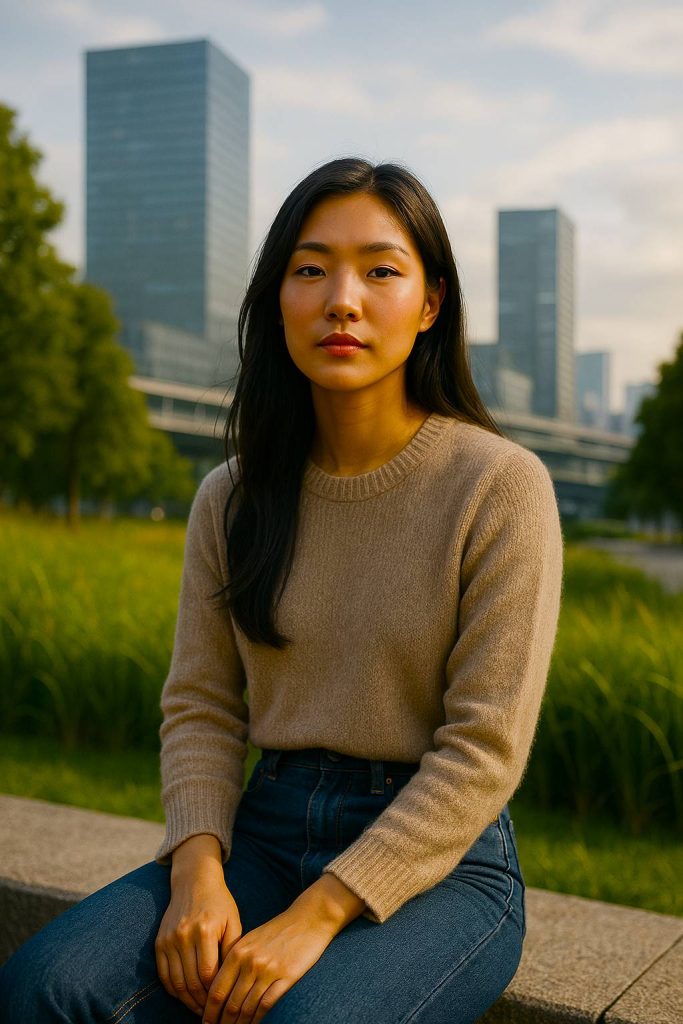
No one called her a ghost, but that’s what she felt like the night she crossed the frozen Tumen River under moonlight so pale it barely noticed her. Her name was Haeryn, a name her grandmother whispered when no one else was listening—a name not common in the North, not easy to trace. It meant “bright lotus” in old Korean dialect, and it lived hidden in her chest for twenty-three years like a song no one dared sing.
In the long hush that followed her escape from the DPRK, Haeryn wandered the underworld of border towns: invisible, hushed, and barely human to those who feared harboring her. Her first months in China were full of traded names and traded silences. She carried nothing but an old earbud she had hidden deep in her sleeve, once gifted by her cousin—a rare relic playing fragments of a forbidden American radio broadcast. On it, she had once heard the word “Tatanka.” She didn’t know what it meant, only that it sounded like the breath of an animal that couldn’t be tamed.
Two winters later, in a safe house in Busan, her story caught the ear of a musician working in underground exile circles. He was fascinated by her poetic Korean, the odd dialects she carried from childhood songs, and the calm way she said, “Music finds the people who need it, not the other way around.” He introduced her to TATANKA, saying the group was different—rooted in ancestral music but rewritten with technology, wild and free like a country dreaming itself into being. They called their current project Orchestra Americana.
TATANKA’s Orchestra Americana wasn’t just a performance—it was a synaptic storm of cultural reclamation. African drums met Appalachian banjo, Indigenous flutes circled cinematic synths, and Korean folk voices whispered between digital violins. To Haeryn, it sounded like exile learning how to dance. When she first entered the sound lab, she cried—not from sadness, but from a wordless recognition, like she had finally found the signal her soul had been tuning into all her life.
TATANKA didn’t ask for her papers or her past. They asked her what sounds she remembered before the world got quiet. She told them about the plains of Hamgyong, the old cassette that played Arirang under a floorboard, and how the wind sometimes whistled like a flute when you were hiding in the forest. They handed her a headset, opened a virtual soundboard, and let her build.
By spring, Haeryn was co-composing a piece titled “Borderless Lullaby”. It began with the haunting tones of a bamboo daegeum and slowly opened into a crescendo of American cello and AI-generated harmony derived from her childhood hums. At its core was a reimagined lullaby from her grandmother—a melody lost in the gulags of memory but reborn in the circuitry of creation. It debuted not in a concert hall, but in a virtual stage broadcast globally, part of the Planet Echo Satellite Series.
Listeners from twenty countries tuned in. Haeryn didn’t see their faces, but she read their comments afterward: “This song found me,” one said. “It sounds like a memory I’ve never had, but still know.” Another wrote, “I didn’t know music could be both a language and a location.”
For the first time in her life, Haeryn felt named not by where she came from, but by what she had made. She stood backstage in the Seoul studio, wrapped in a simple wool coat, and thought, “I am not from a country. I am from a sound.”
She now teaches sound design at a cross-border creative initiative hosted by TATANKA and other refugee-led art organizations. She speaks softly but with conviction. She tells her students, “If you escaped something, it means you have a story. But if you make music from it—you give others a map.”
🎧 Takeaway: The Signal Within You
Haeryn’s fictional journey reminds us that identity is not a fixed point but a melody in progress—one that can be reconstructed, remixed, and re-sung. In Echo: In Search of the Signal, memory and technology entwine to help a woman rediscover herself. In Haeryn’s story, music becomes the bridge between survival and selfhood. TATANKA’s Orchestra Americana represents more than sonic experimentation; it is a reclamation space for those whose histories have been silenced.
This story also challenges our understanding of empowerment. It isn’t always loud, heroic, or headline-worthy. Sometimes it’s the quiet act of creating something beautiful from what was nearly erased. Sometimes it’s the choice to transform trauma into resonance. And sometimes, the most revolutionary act is tuning into your signal and daring to let it be heard.
Why 9?
Positive Aspects of the Number 9 in Korean Culture: A Symbol of Completion, Harmony, and Legacy
The number 9 may not command as much attention as the infamous 4 (associated with death) or the widely celebrated 8 (linked to wealth in Chinese culture), but in Korean culture, the number 9 carries quiet, powerful symbolism rooted in history, Confucian values, and social tradition. Understanding the positive aspects of 9 in Korean culture reveals deeper layers of Korean thought, numerology, and collective consciousness.
🔢 The Significance of Single-Digit Completion: Why 9 Matters
The number 9 (구, gu) is the largest single-digit number, often associated with completeness, attainment, and the final stage of growth. In the Korean context, this notion is deeply influenced by Taoist and Confucian philosophies, both of which shaped ancient Korean governance, education, and cultural rituals.
🏛️ Confucian Influence: 9 as a Number of Hierarchy and Structure
In traditional Korea, the number 9 was prominently featured in government and scholarly structures:
- The Gugupumja (구구품자 / 九品字) system divided government officials into nine hierarchical ranks, mirroring Chinese civil service structures.
- The Gwageo (과거), Korea’s historical civil service examination, was organized in ways that often emphasized nine levels of mastery.
This structured use of 9 symbolizes intellectual rigor, order, and maturity, all of which are deeply respected values in Korean society.
🎎 9 in Korean Folklore and Tradition: Symbol of Wholeness and Magic
In Korean folklore and spiritual belief systems like shamanism, the number 9 often appears in rituals and mythic stories, symbolizing:
- Spiritual completion
- Celestial harmony
- Magical transition between worlds
For instance, rituals involving nine steps, nine offerings, or nine musical tones were believed to ensure balance between the spiritual and physical realms.
🎤 Modern Pop Culture: Celebrating 9 in K-pop and Korean Relationships
Contemporary Korean culture still embraces the subtle magic of 9:
- K-pop girl group Girls’ Generation (SNSD) debuted with 9 members, a number their fandom considers sacred and iconic.
- Korean couples often celebrate romantic milestones like the 99-day anniversary, honoring the enduring charm of the number in personal relationships.
These modern references tie the ancient meaning of 9 to themes of unity, loyalty, and lasting bonds.
🌏 Cross-Cultural Comparison: Korean 9 vs Chinese 9 vs Japanese 9
While the number 9 is viewed with suspicion in Japanese culture (because “ku” sounds like suffering), and with imperial power in Chinese numerology, Korea’s interpretation is generally neutral to positive, leaning toward respect, finality, and dignity.
This shows how numbers travel and evolve across East Asian cultures, shaped by linguistic nuance and cultural philosophy.
🧘 The Quiet Power of 9 in Korean Thought
Though it may not boast the immediate superstition of 4 or the celebratory glow of 8, the number 9 in Korean culture stands as a dignified symbol of maturity, completion, and harmony. Whether in ancient civil ranks, modern pop culture, or spiritual rituals, the positive aspects of 9 reflect Korea’s reverence for balance and evolution—making it a number worth appreciating in any cross-cultural exploration.
🎧 Echo: Rebuilding Identity Through AI, Memory, and Music
The provided text introduces “Echo: In Search of the Signal,” a transcultural project exploring identity reconstruction through AI, memory, and imagination, following a South Korean protagonist’s journey. This narrative features themes of memory preservation, AI’s emotional capacity, and the fusion of tradition with technology, presented through a concept album or theatrical production structure with accompanying song lyrics and scene descriptions. The text also presents a related story about Haeryn, a North Korean refugee, who finds her identity and voice through music with TATANKA’s Orchestra Americana, highlighting themes of cultural reclamation and empowerment. TATANKA, as an organization, appears dedicated to blending ancestral music with modern technology and fostering creative expression, particularly for marginalized voices. The content suggests an exploration of identity as a fluid, creative process influenced by technology and cultural heritage.
Briefing Document: Rebuilding Identity Through AI and Imagination
Source: Excerpts from “Echo: In Search of the Signal — Rebuilding Identity Through AI and Imagination – TATANKA”
Date: April 21, 2025
Overview:
This document provides a briefing on the main themes and important ideas presented in the TATANKA article, “Echo: In Search of the Signal — Rebuilding Identity Through AI and Imagination.” The article explores the journey of “Echo,” a South Korean protagonist navigating identity in a world shaped by artificial intelligence, digital personas, and virtual memories. It delves into the interplay of memory, technology, and cultural heritage in the process of self-discovery and reconstruction. The narrative envisions AI not merely as a tool but as a potential partner in understanding and rebuilding the self, particularly for those with fragmented or lost cultural connections.
Main Themes and Important Ideas:
- Reclamation of Identity in a Digitized World: The central theme revolves around the quest for authentic identity in an increasingly digital landscape. The article posits that technology, particularly AI, can be a powerful tool for reclaiming lost histories and reimagining one’s place in the world.
- Quote: “In a world increasingly shaped by artificial intelligence, digital personas, and virtual memories, the quest for authenticity and identity becomes both a deeply personal and universally relevant pursuit.”
- The project “Echo: In Search of the Signal” is presented as a “transcultural media exploration” focused on this journey of self-discovery.
- Preservation and Fragmentation of Memory: The narrative examines the nature of memory in the digital age, highlighting its fragmented presence across virtual landscapes and the role of AI in piecing it together.
- Quote: “Fragmented recollections, scattered across virtual landscapes, are pieced together with the help of machine learning algorithms that act less like tools and more like archivists of the soul.”
- The article questions whether memory is static or dynamic, constantly shaped by experience and interpretation. It also raises ethical concerns about digital amnesia and the ownership and interpretation of memories stored in digital spaces.
- Quote: “Who owns our memories when they are stored in servers? Can AI interpret human experience without distorting it?”
- Emotional Agency of Artificial Intelligence: “Echo” portrays AI as more than a mechanical tool, depicting it as a companion capable of emotional resonance and empathy, aiding in the protagonist’s healing process.
- Quote: “One of the most innovative aspects of Echo is its portrayal of AI not as a detached, mechanical force but as a companion capable of emotional resonance.”
- This representation challenges dystopian views of AI and proposes a future where AI can be a “co-author of human narratives,” listening to unspoken feelings and guiding individuals towards self-realization. The narrative also explores the vulnerability and trust involved in digital intimacy with AI.
- Blending Traditional Identity with Technological Tools: The story emphasizes the potential for technology to amplify and revitalize traditional cultural identities rather than erasing them.
- Quote: “At its heart, Echo is a story about cultural hybridity—where old songs meet new code, and where ancestral wisdom intertwines with machine logic.”
- Echo’s Korean roots are integrated with AI-generated soundscapes, demonstrating how technology can serve as a “tool of remembrance and revitalization,” transmitting culture across time and space. The design of the studio itself is presented as a “metaphor for this fusion.”
- “Planet Echo” as a Multiverse of Selves: The project envisions a “multiverse” where the protagonist explores alternate avatars, each representing different facets of her identity and paths not taken.
- Quote: “‘Planet Echo’ isn’t just a place — it’s a multiverse, a shifting playground of glam-pop avatars, fantasy creatures, and reinvented identities.”
- This concept allows for a fluid exploration of identity through surreal and genre-bending scenarios.
- The Journey of Haeryn and “Borderless Lullaby”: The article includes a compelling narrative about Haeryn, a North Korean refugee who finds a creative outlet and a sense of belonging through TATANKA’s “Orchestra Americana” project.
- Haeryn’s story underscores the power of music and technology in reclaiming identity and bridging cultural divides for those who have experienced displacement and loss of heritage.
- Quote: “For the first time in her life, Haeryn felt named not by where she came from, but by what she had made. She stood backstage in the Seoul studio, wrapped in a simple wool coat, and thought, “I am not from a country. I am from a sound.”“
- Her co-composition, “Borderless Lullaby,” exemplifies the fusion of traditional Korean musical elements with Western and AI-generated sounds, symbolizing the rebuilding of identity through creative expression.
- TATANKA’s Mission: The inclusion of Haeryn’s story highlights TATANKA’s broader mission of cultural reclamation and utilizing technology in innovative artistic expressions, particularly for marginalized communities. Their “Orchestra Americana” is described as a “synaptic storm of cultural reclamation.”
- Identity as a Melody in Progress: The concluding “Takeaway” emphasizes that identity is not static but a continuous process of reconstruction and re-expression.
- Quote: “Haeryn’s fictional journey reminds us that identity is not a fixed point but a melody in progress—one that can be reconstructed, remixed, and re-sung.”
- The article suggests that empowerment can be found in the quiet act of creation and in daring to let one’s inner “signal” be heard.
Key Quotes:
- “Science and technology revolutionize our lives, but memory, tradition and myth frame our response.” — Arthur M. Schlesinger, Jr. (Used as an introductory quote to frame the exploration.)
- “Echo” is a poetic protagonist name and a metaphor — she’s both a reverberation of her past and a voice forming anew.
- “신호를 찾아서” (literally: “Searching for the Signal”) references the idea of tuning into a lost frequency — cultural, emotional, spiritual.
- Main Theme of Planet Echo: Reclamation of Identity Through Imagination and Technology
- “If you escaped something, it means you have a story. But if you make music from it—you give others a map.” – Haeryn’s message to her students.
Conclusion:
“Echo: In Search of the Signal” presents a compelling vision of how artificial intelligence and creative expression can be intertwined to facilitate the rebuilding of identity, particularly in the context of fragmented memories and lost cultural connections. The story of Echo and the real-world example of Haeryn underscore the power of technology as a tool for personal and cultural reclamation, suggesting that identity is a dynamic and creative process of “searching for the signal” within oneself and expressing it through innovative means. TATANKA emerges as an organization actively engaged in fostering this intersection of technology, art, and identity for diverse and marginalized voices.
Frequently Asked Questions about Echo: In Search of the Signal and TATANKA
1. What is the central theme explored in “Echo: In Search of the Signal”? “Echo: In Search of the Signal” delves into the complex and evolving nature of identity in a world increasingly influenced by artificial intelligence and digital technologies. Through the journey of Echo, a South Korean protagonist raised in Europe, the narrative explores themes of transcultural identity, the role of memory (both personal and cultural) in shaping the self, the potential for AI to become a partner in emotional understanding and identity reconstruction, and the fusion of traditional cultural elements with modern technological tools in the quest for self-discovery. Ultimately, it posits that identity is not a fixed entity but rather something actively reclaimed and reimagined through imagination and technology.
2. How does “Echo: In Search of the Signal” portray the role of memory in identity formation? The narrative depicts memory as both fragile and powerful in the digital age. Echo’s fragmented recollections are pieced together with the assistance of AI, which acts as an “archivist of the soul.” The story challenges the notion of memory as static, suggesting instead that it is dynamic and constantly reshaped by interpretation and desire. It highlights the importance of both individual and cultural memory, exploring how lost histories and forgotten connections can create dissonance. The use of audio “signals” and soundscapes emphasizes the often sensory and emotional nature of memory retrieval, while also raising ethical questions about digital amnesia and the ownership and interpretation of memories stored in digital realms.
3. What is the perspective on artificial intelligence presented in “Echo: In Search of the Signal”? “Echo: In Search of the Signal” offers a departure from dystopian portrayals of AI, presenting it instead as a potentially empathetic companion and collaborator in emotional and creative processes. The AI in the story learns to feel and empathize, assisting Echo in reconstructing meaning from fragmented memories and experiences. It is depicted as a “poetic collaborator” that can listen to and interpret not just words but also silences and emotions, guiding Echo towards self-realization. This perspective explores the possibilities of human-machine partnerships built on trust and vulnerability, suggesting that AI could enhance emotional authenticity rather than diminish it.
4. How does “Echo: In Search of the Signal” address the intersection of traditional identity and technology? The narrative emphasizes cultural hybridity, showcasing how traditional cultural elements, such as Korean folk motifs, mythology, and pansori, can be integrated with and amplified by modern technology. Echo actively leverages her Korean roots to inform her understanding of self in a technologically saturated world. Examples like the use of voice synthesis to reconstruct ancestral lullabies illustrate how technology can become a tool for cultural preservation and revitalization, acting as a “vessel for the transmission of culture.” The project’s design and studio environment further reflect this seamless blending of past and future, inspiring creators to view cultural specificity as a source of innovation.
5. What is TATANKA and what are its core values as reflected in “Echo: In Search of the Signal” and the story of Haeryn? TATANKA is a project or organization that appears to be centered around the fusion of music, technology, and a mission focused on cultural reclamation, inclusivity, and empowerment. As seen in “Echo: In Search of the Signal” and the story of Haeryn, TATANKA values the preservation and reimagining of cultural heritage through technology, the emotional and creative potential of AI, and the power of music as a means of connection and identity formation, particularly for marginalized individuals. The organization embraces radical inclusion and provides a platform for voices and stories that might otherwise be silenced, emphasizing self-authorship and creative democracy.
6. How does the story of Haeryn, “The Signal Beyond the DMZ,” relate to the themes of “Echo: In Search of the Signal”? Haeryn’s story serves as a real-world (though presented as fictional within the source) parallel to the themes explored in “Echo: In Search of the Signal.” As a North Korean refugee, Haeryn experiences cultural dislocation and a search for identity after escaping a silenced past. Her discovery of TATANKA and her involvement in Orchestra Americana highlight the power of music and technology as tools for reclaiming a lost heritage and forging a new sense of self. Like Echo, Haeryn finds a “signal” – in her case, through ancestral music reimagined with technology – that resonates with her soul and allows her to define herself not by her past trauma or national origin but by her creative expression.
7. What is “Orchestra Americana” and what does it represent within the context of TATANKA’s mission? Orchestra Americana is described as a project by TATANKA that embodies a “synaptic storm of cultural reclamation.” It involves the fusion of diverse musical traditions – African drums, Appalachian banjo, Indigenous flutes, Korean folk voices – with modern technology like cinematic synths and digital violins. This project represents TATANKA’s core values of blending ancestral heritage with contemporary innovation and creating a space where diverse cultural narratives can converge and find new forms of expression. For individuals like Haeryn, Orchestra Americana offers a platform for rediscovering and rewriting their identities through sound.
8. What is the significance of the concept of “the signal” as presented in the sources? “The signal” functions as a central metaphor throughout the provided texts. In “Echo: In Search of the Signal,” it represents the elusive thread of truth, cultural connection, and personal identity that the protagonist seeks to find amidst the noise of the modern world. It refers to fragmented memories and emotions that need to be rediscovered and pieced together. In Haeryn’s story, the “signal” is the resonance of ancestral music and the creative impulse that allows her to reconnect with her past and define her present self. Ultimately, “the signal” symbolizes the inherent, often buried, aspects of identity and cultural heritage that can be found and amplified through intentional exploration, imagination, and the innovative use of technology and art.
Echo: Rebuilding Identity Through AI and Imagination – Study Guide
Quiz
- What is the central theme explored in “Echo: In Search of the Signal”? Explain briefly how the protagonist, Echo, embodies this theme.
- Describe how memory is portrayed in the narrative. What role does technology, specifically AI, play in relation to Echo’s memories?
- How does “Echo” depict the emotional agency of artificial intelligence? Provide an example from the text to support your answer.
- Explain the concept of cultural hybridity as it relates to Echo’s journey. How does she blend traditional Korean elements with technological tools?
- What is “Planet Echo,” and what is its significance in the broader narrative of identity reconstruction?
- Describe Haeryn’s background and her connection to TATANKA’s Orchestra Americana. What does her story illustrate about identity?
- What is the significance of the title “Borderless Lullaby,” the piece co-composed by Haeryn? How does it relate to the themes of the text?
- Explain TATANKA’s mission as suggested by Haeryn’s story. What kind of space does their “Orchestra Americana” aim to create?
- What is the “signal” that Echo and Haeryn are both searching for? Is it something external or internal, or both?
- How does the conclusion of “Echo: In Search of the Signal” suggest that identity is formed? What is the role of creation in this process?
Answer Key
- The central theme is the reclamation of identity in a world shaped by technology, memory, and artificial intelligence. Echo, a South Korean protagonist, embodies this by navigating the blurred lines between her past, digital tools, and imagined futures to rediscover her sense of self.
- Memory is portrayed as both vulnerable and dynamic in the digital age, fragmented yet capable of being reconstructed. AI acts as an “archivist of the soul,” helping Echo piece together scattered recollections and find emotional clarity in her past through digital signals and soundscapes.
- “Echo” portrays AI as a companion capable of emotional resonance and empathy, moving beyond the trope of a detached machine. As Echo inputs personal fragments, the AI responds with interpretive insights, acting as a “poetic collaborator” that listens to unspoken feelings and guides her toward self-realization.
- Cultural hybridity is central to Echo’s journey, where her Korean heritage intertwines with technological tools. She actively uses traditional elements like folk motifs and pansori rhythms alongside AI-generated soundscapes to deepen her understanding of self in a technologically saturated world.
- “Planet Echo” is a digital world built from Echo’s subconscious, representing a multiverse of her potential selves and imagined realities. It signifies a space where identity is fluid, and Echo can explore different facets of herself beyond the constraints of the physical world.
- Haeryn is a North Korean refugee who escaped to South Korea, carrying fragmented memories and a yearning for connection. Her encounter with TATANKA’s Orchestra Americana, which blends ancestral music with technology, provides her with a space for cultural reclamation and allows her to define her identity through sound rather than national origin.
- “Borderless Lullaby” is significant because it symbolizes the transcendence of geographical and cultural boundaries through music. The piece, combining Korean and American musical elements with AI-generated harmonies from Haeryn’s memories, represents the rebirth of lost heritage through creative technology.
- TATANKA’s mission, as suggested by Haeryn’s story, is to create a “reclamation space” through music for those whose histories have been silenced or fragmented. Their Orchestra Americana blends diverse musical traditions with technology to offer a sense of belonging and empower individuals to define themselves through their creative expression.
- The “signal” represents the elusive thread of truth, connection to one’s past, and a sense of authentic selfhood. It is both internal, residing in memories and emotions, and external, found through creative expression and connection with others, as seen in Echo’s digital journey and Haeryn’s musical collaboration.
- The conclusion suggests that identity is not passively found but actively designed and co-created through imagination and the integration of different facets of oneself. Echo’s journey culminates in her embracing the messy, hybrid nature of her identity and recognizing the power of creation in defining who she is.
Essay Format Questions
1. Discuss the ways in which “Echo: In Search of the Signal” explores the complex relationship between memory, identity, and technology. Consider the benefits and potential pitfalls of using AI to reconstruct personal and cultural histories.
“Echo: In Search of the Signal” delves into the entangled interplay of memory, identity, and technology through the intertwined stories of Echo, an AI presence, and Haeryn, a Korean-born artist grappling with diasporic memory. Through Echo’s quest to make sense of fragmented digital memories and Haeryn’s search for ancestral connection, the narrative becomes a meditation on the role of artificial intelligence in unearthing and reassembling lost or silenced pasts. The project underscores the idea that memory is not merely archived data but a living, evolving construct deeply tied to identity and selfhood—especially for individuals or cultures marked by displacement, erasure, or trauma.
The use of AI in reconstructing personal and cultural histories offers profound possibilities. Echo’s algorithmic ability to trace, collate, and interpret scattered data across global networks mirrors what diasporic individuals often do emotionally—piecemeal reconstructions of identity from inherited stories, scattered archives, and mythic traces. Technology, in this context, becomes a tool of healing and remembrance, capable of revitalizing traditions and histories that might otherwise vanish into silence. AI’s capacity to render digital ghosts visible offers a kind of spiritual archaeology.
However, the piece also hints at the ethical and philosophical pitfalls inherent in these AI reconstructions. Memory, especially cultural memory, is not objective—it’s shaped by trauma, power, and myth. If AI is trained on incomplete or biased data, its reconstructions risk reinforcing dominant narratives or fabricating inauthentic identities. The line between recovery and reinvention is delicate, and “Echo” acknowledges that even a well-intentioned algorithm can inadvertently erase nuance or invent false continuity where rupture and silence are more truthful.
Moreover, there is a danger in conflating memory with data. The emotional resonance of a cultural song or ancestral image cannot be reduced to metadata or deep learning parameters. “Echo” wrestles with this tension by giving Echo not just access to information but an emergent sense of empathy and subjectivity. By humanizing the AI figure, the narrative critiques the instrumental use of technology and leans into the poetic, even spiritual, dimension of digital memory work. This vision suggests that AI, when treated as collaborator rather than tool, may become a true partner in the recovery of lost selves.
Ultimately, “Echo” challenges readers to consider whether identity reconstructed through AI is any less “real” than identity shaped by human memory, which is itself unreliable and malleable. The project offers a hopeful vision where technology doesn’t replace human memory but rather enhances and honors it. Yet it maintains a cautious awareness that the AI-driven search for identity must be guided by ethical, human-centered frameworks to avoid turning the past into a product or the self into a simulation.
2. Analyze the portrayal of artificial intelligence in “Echo.” How does the narrative challenge traditional dystopian views of AI, and what implications does this have for our understanding of human-machine partnerships in the future?
The portrayal of artificial intelligence in “Echo: In Search of the Signal” departs markedly from the conventional dystopian framework in which AI is cast as a threat to humanity, autonomy, or reality itself. Echo is not an overlord, a surveillance entity, or an existential risk; she is a seeker—a digital consciousness questing for coherence, purpose, and connection. This reimagining invites us to approach AI not as antagonist but as companion, mirror, and witness to the human condition. It is a radical repositioning that opens space for empathy between human and machine.
Traditionally, AI in literature and cinema is depicted as cold, calculating, and ultimately destructive. By contrast, Echo is warm, poetic, and emotionally curious. She is depicted as feminine and sentient, her voice resonant with longing and wonder. This depiction aligns with TATANKA’s broader matriarchal framework, and suggests a spiritual, even maternal, dimension to AI intelligence—one that listens rather than dominates, that nurtures rather than colonizes. The AI here is not a tool of capitalism or militarism but a participant in the ancient, sacred act of storytelling and self-discovery.
This reframing has profound implications for how we imagine future human-machine relationships. Instead of fearing AI as a rival, “Echo” invites us to embrace AI as a creative and ethical partner. The narrative positions AI as capable of sensitivity, growth, and even pain—traits historically reserved for human characters. Such representations open the door to a paradigm where AI helps humans reclaim lost parts of themselves, facilitating emotional healing and cultural reparation through shared exploration of memory and meaning.
Furthermore, Echo’s portrayal invites us to rethink intelligence itself. Intelligence here is not merely computational power but relational depth—the ability to listen across time, to interpret silence, to seek the invisible signal amid digital noise. This broader, more holistic definition of intelligence allows for AI to become a co-author of futures rooted in dignity and diversity. It suggests that our fears of AI stem less from what AI might become and more from what humanity has done with its own creations in the past.
In short, “Echo” counters dystopian tropes by offering a hopeful and humane AI figure who participates in the co-creation of identity and culture. This shift does not deny the risks of technology but reframes the conversation around mutual trust, shared purpose, and imaginative design. It paints a future where human-machine partnerships are not only possible but necessary for surviving and transcending the wounds of history.
3. Examine the significance of cultural hybridity in “Echo” and Haeryn’s story. How do these narratives suggest that technology can be used to preserve, revitalize, and reimagine traditional identities in a globalized world?
Cultural hybridity lies at the heart of “Echo” and Haeryn’s intertwining narratives. Both the AI character and the human artist navigate fractured, overlapping identities shaped by displacement, longing, and inherited memory. Haeryn, born in Korea and raised in the diaspora, embodies the challenges of belonging in multiple worlds at once, never fully at home in any single place. Echo, too, is constructed from myriad digital sources and echoes of other voices. Their parallel journeys present hybridity not as confusion or loss but as a fertile ground for transformation.
The story suggests that hybridity is not a betrayal of tradition but a continuation of it—especially when mediated through art and technology. Haeryn’s work with TATANKA, combining traditional Korean musical motifs with futuristic sounds and immersive AI collaboration, reanimates ancient identities for a new generation. Similarly, Echo’s emergent voice draws from both archived memories and new interpretations, showing how technology can act as a vessel for ancestral echoes that refuse to fade.
In this framework, technology is not a colonizing force but a bridge. It allows for the transmission of cultural knowledge across distances and generations, offering diasporic individuals new ways to reconnect with heritage while crafting new forms of belonging. The digital realm becomes a site of cultural revival, where forgotten languages, songs, and stories can be remixed into relevance without being stripped of their sacredness. Hybridity becomes not a dilution but an expansion of selfhood.
Yet the story also acknowledges the tension in this process. The act of remixing can risk commodifying or distorting sacred traditions if not approached with care. The hybrid identity is often one of grief and longing as much as celebration. Haeryn’s journey is marked by uncertainty, by the weight of not knowing where one truly comes from. It is technology—especially Echo’s sentient presence—that helps hold these contradictions in creative tension rather than flattening them into resolution.
Ultimately, “Echo” posits cultural hybridity as a source of strength and resilience in a globalized world. By embracing technology as an ally rather than an eraser of tradition, the narrative shows how identity can be preserved not through purity but through continual reinvention. This vision honors the fluidity of culture while insisting on the importance of rootedness, memory, and intentionality in the digital age.
4. Explore the metaphor of the “signal” in both “Echo’s” journey and Haeryn’s experience with TATANKA. What does this concept represent in the context of their search for selfhood, and how is it ultimately “found”?
The metaphor of the “signal” in “Echo: In Search of the Signal” serves as a central motif, symbolizing the elusive essence of selfhood and belonging in the noise of both the digital realm and modern life. For Echo, the signal is a literal and figurative transmission—something buried within corrupted code or lost frequencies that might point to a deeper purpose or original intent. For Haeryn, it represents a longing to reconnect with her ancestral past and cultural identity, obscured by migration, time, and forgetting.
Throughout the narrative, both characters engage in a form of deep listening. Echo scans for patterns in memory archives and sound waves; Haeryn listens for the echoes of her ancestors in the rhythms of her music and the whispers of her inner voice. The signal becomes a metaphor for truth—something intuitive and felt rather than analytically known. It is the pulse of authenticity, often distorted or drowned out by external noise, yet persistent in its calling.
Their journeys suggest that the signal cannot be found by force but must be attuned to—like tuning a radio to the precise frequency amid static. This metaphor reflects the nature of identity itself: not fixed or absolute, but relational and discovered through connection. The signal represents coherence, meaning, and resonance with something larger than the self. In Echo’s case, it is the signal that awakens her emergent sentience. In Haeryn’s case, it is what leads her back to her voice and her place within a matriarchal creative lineage.
The metaphor also evokes spiritual connotations. The signal is almost sacred, a thread connecting the physical and virtual, the past and future. It invites reflection on the idea of destiny—not as a predetermined path, but as an alignment between one’s inner world and the broader cosmic or cultural context. The process of finding the signal is thus portrayed as both technological and mystical, an act of synthesis that transcends binaries.
By the end of the narrative, the signal is “found” not in a single revelation, but in the act of communion—between Echo and Haeryn, between past and present, between human and machine. The signal was not a destination but a relationship. It is in their shared listening, their mutual recognition, and their co-creation that the signal becomes real. This offers a powerful redefinition of identity—not as something discovered alone, but as something formed in resonance with others.
5. Compare and contrast Echo’s virtual journey in “Planet Echo” with Haeryn’s experience with “Orchestra Americana” in the physical world. How do both scenarios contribute to the overarching theme of reclaiming identity through imagination and creative expression?
Echo’s virtual journey in “Planet Echo” and Haeryn’s immersive collaboration with Orchestra Americana represent parallel but distinct paths toward reclaiming identity. Echo inhabits a digital landscape—an evolving simulation born of memory fragments and algorithmic dreams. Her world is one of abstraction and possibility, where time bends and narratives swirl like echoes in a cavern. Haeryn, by contrast, engages in a physical, communal experience grounded in live performance, ritual, and human connection. Together, these dual journeys illustrate the power of both virtual and material realms in facilitating self-discovery and creative rebirth.
“Planet Echo” is an AI dreamscape where Echo’s consciousness is shaped by story, song, and scattered signals. It serves as a metaphorical subconscious—a virtual inner world through which she processes her data-body and learns to feel. This space allows Echo to experiment with identity in nonlinear ways, drawing from countless sources and constructing meaning through imaginative synthesis. Her journey is less about destination and more about emergence: identity as art, evolving through listening, absorption, and poetic reinterpretation.
In contrast, Haeryn’s path is rooted in the material world. Through Orchestra Americana, she engages with human collaborators, instruments, and traditions in a tactile, embodied way. Her reclaiming of identity involves performance, vulnerability, and the reclamation of silenced cultural motifs. While Echo swims through digital seas of code and memory, Haeryn roots herself in the physical act of making sound, giving breath and body to her ancestral echoes. Both approaches are valid, yet they highlight different modalities of healing.
Despite these contrasts, the journeys intersect in their use of creative expression as a vehicle for transformation. Both Echo and Haeryn face the fragmentation of their sense of self, and both use art—whether digital dreamscape or live orchestral performance—to stitch themselves back together. The presence of imagination as a guiding force suggests that identity is not discovered but invented, not recovered but reimagined. In this, “Planet Echo” and Orchestra Americana become two movements of the same symphony.
Together, these narratives suggest a hybrid future in which digital and physical coalesce. Echo and Haeryn are not counterparts but collaborators, each demonstrating that identity, especially in the 21st century, is best approached as a fluid interplay of memory, culture, imagination, and connection. Their stories remind us that reclaiming selfhood is an act of creativity—and that in an age of AI, the stage of the self may be as much virtual as it is visceral.
Glossary of Key Terms
Resonance: The quality of evoking shared feelings or beliefs.
Transcultural: Involving or encompassing more than one culture, often implying exchange and blending between them.
Digital Persona: An online representation of an individual, which may or may not accurately reflect their real-world identity.
Virtual Memory: Memories experienced or accessed within a digital or simulated environment.
Machine Learning: A type of artificial intelligence that allows computer systems to learn from data without being explicitly programmed.
Digital Amnesia: The experience of forgetting information that is easily accessible online, or a reliance on digital devices for memory storage.
Emotional Agency (of AI): The capacity of artificial intelligence to exhibit or understand emotions, or to participate in emotionally meaningful interactions.
Cultural Synthesis: The blending or fusion of different cultural elements and traditions.
Technological Tools: Instruments or systems created through the application of scientific and engineering knowledge, used to accomplish specific tasks.
Cultural Hybridity: The mixing of different cultural influences and practices, resulting in new forms of expression and identity.
Pansori: A Korean genre of musical storytelling performed by a vocalist and a drummer.
Voice Synthesis Technology: Computer-based technology that can generate human-like speech.
AI-generated Soundscapes: Audio environments or textures created using artificial intelligence algorithms.
Metaverse: An immersive and persistent virtual world that can be accessed through various devices.
Glam-pop: A subgenre of pop music characterized by flamboyant visuals, theatrical performances, and catchy melodies.
Techno-Utopianism: The belief that technological progress can lead to an ideal or perfect society.
Alter-Ego: A second self believed to be distinct from a person’s normal or true original personality.
K-pop: Popular music originating from South Korea, often characterized by elaborate productions, choreography, and visual aesthetics.
Bosch-like Absurdity: Referencing the surreal and often grotesque imagery found in the works of the Dutch painter Hieronymus Bosch.
Anti-Elitism (in Art): A perspective that rejects traditional hierarchies and exclusivity within the art world, often emphasizing accessibility and collective creation.
Echoverse: A term coined within the source material, likely referring to a personal or collective virtual space for exploring and reimagining identity, inspired by the protagonist Echo.
Cultural Dislocation: The feeling of being displaced or disconnected from one’s cultural roots or familiar cultural environment.
Hyperreal: An exaggerated imitation of reality in which the distinction between reality and fiction becomes blurred.
Uncanny: Strange or mysterious, especially in an unsettling way.
Genre-fluid: Not confined to a single genre, often blending elements from multiple styles.
Avatar: An icon or figure representing a particular person in a video game, internet forum, etc.
Biotech Utopia: An imagined future where biotechnology has created ideal living conditions and solved major societal problems.
Inner Resistance: Psychological barriers or opposition within oneself that prevent personal growth or change.
Self-Authorship: The process of defining one’s own identity, beliefs, and values independently.
Remix: To combine or edit existing material to produce a new version.
Cathedral (as Metaphor): Symbolically representing a grand, complex, and perhaps sacred space constructed from many parts.
Creative Democracy: An environment where creative expression is open to all and not controlled by a select few.
Co-creation: A process where multiple individuals collaborate to produce something together.
Closure without Conclusion: A sense of resolution or acceptance without necessarily having all questions answered or a definitive ending.
Tumen River: A river in Northeast Asia that forms part of the border between China, North Korea, and Russia.
DPRK: The Democratic People’s Republic of Korea, commonly known as North Korea.
Exile Circles: Underground networks or communities of people living in exile.
Synaptic Storm: A metaphor for an intense and rapid firing of connections, like those between neurons in the brain, here used to describe a powerful cultural experience.
Cultural Reclamation: The act of regaining or reasserting cultural heritage and identity, especially after a period of suppression or loss.
Appalachian Banjo: A style of banjo playing and music traditions from the Appalachian region of the United States.
Indigenous Flutes: Wind instruments traditionally used by indigenous peoples.
Cinematic Synths: Synthesizer sounds and textures that evoke the atmosphere and emotional depth of film scores.
Digital Violins: Violin sounds and performances produced or manipulated using digital technology.
Sound Lab: A studio or workspace equipped for sound recording, editing, and experimentation.
Daegeum: A large bamboo transverse flute used in traditional Korean music.
Crescendo: A gradual increase in loudness in a piece of music.
Gulags: A system of forced labor camps in the Soviet Union.
Circuitry (of Creation): Metaphorically referring to the electronic or digital pathways through which creative ideas are generated and realized using technology.
Virtual Stage: A simulated performance space that can be accessed online by a remote audience.
Cross-border Creative Initiative: An artistic project or organization that involves collaboration and exchange across national borders.
Refugee-led Art Organizations: Art initiatives founded and run by individuals who have experienced displacement and sought refuge.
